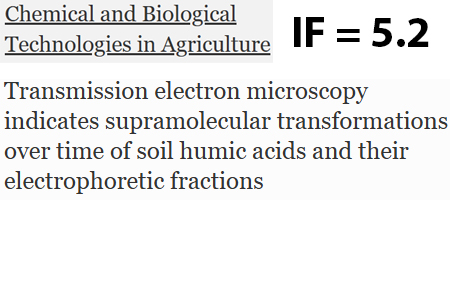
Российские ученые впервые эксперментально подтвердили супрамолекулярное строение природных гуминовых веществ
Группой молекулярной экологии ФИБХ РАН в тесной кооперации с учеными из институтов ФИЦ ПНЦБИ РАН с помощью комплекса оригинальных методик впервые получены экспериментальные данные о супрамолекулярной (надмолекулярной) структуре природных гуминовых веществ. Установлено, что различные типы морфологических надмолекулярных наноструктур связаны с определенным химическим составом и различными экологическими и биогеохимическими функциями гуминовых веществ. Работа опубликована в престижном научном журнале Chem. Biol. Technol. Agric., ИФ-5.2, Q1 (издательство Springer Nature).
Новости 
- Научные достижения ГНЦ ИБХ РАН в 2025 году
наука
29.XII.25 На заседании Ученого Совета ГНЦ ИБХ РАН 29 декабря 2025 г. были представлены результаты научной деятельности подразделений Института за 2025 год. Вашему вниманию предлагается презентация директора А.Г. Габибова, а также список достижений, поданных подразделениями на сайте.
- Премия в области будущих технологий «ВЫЗОВ» в номинации «ПРОРЫВ» присуждена Илье Ямпольскому
наука
15.XII.25 За расшифровку молекулярных механизмов биолюминесценции и создание светящихся растений
- Комбинат питания поздравляет сотрудников с наступающим Новым годом!
прочее
8.XII.25 Уважаемые дамы и господа! С Наступающим Новым 2026 годом! Мы рады предложить Вам к праздничному столу самые любимые наши закуски и блюда! Заявки принимаем до 28 декабря 16:00. Последний день работы и отдачи заказов - 30 декабря. Заказы можно оформить в столовой и буфетах или лично у меня. Меню и форма заказа прилагаются. С уважением, Начальник КП Редозубов Сергей Анатольевич (8-910-002-17-84).
События 
- XXXVIII международная зимняя молодежная научная школа «Перспективные направления физико-химической биологии и биотехнологии»
наука
9–11.II Учебно-научный центр Государственного научного центра Института биоорганической химии им. академиков М.М.Шемякина и Ю.А.Овчинникова Российской академии наук (далее - ГНЦ ИБХ РАН) приглашает школьников старших классов, студентов, аспирантов и молодых ученых в возрасте до 35 лет, проводящих научные исследования в области биоорганической химии, молекулярной биологии, биохимии, биотехнологии и биомедицины, принять участие в работе XXXVIII международной зимней молодёжной научной школы "Перспективные направления физико-химической биологии и биотехнологии" (далее – Школа-2026). Школа-2026 будет проведена в ГНЦ ИБХ РАН с 9 по 11 февраля 2026 года.
- Семинар Отдела функционирования живых систем
наука
18.XII.25 (Событие окончено) 18 декабря, в четверг, 15-00, корп. 32, комн. 408 состоится заседание семинара Отдела функционирования живых систем. Повестка дня: 1. А.А. Михайлов "Скелетное редактирование у актинобактерий".2. Н.В. Антипова «Тестирование потенциальных химиопрепаратов на коллекции первичных культур глиобластом: изучение механизмов устойчивости».
- Заседание Диссертационного совета ГНЦ ИБХ РАН
диссертационный совет
17.XII.25 (Событие окончено) 17 декабря, в среду, в 11.00 в Малом зале БОНа состоится заседание Диссертационного совета.











